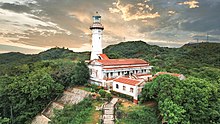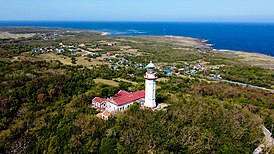Lighthouse
 The lighthouse in 2021 The lighthouse in 2021 | |
| Location | Burgos Ilocos Norte Philippines |
|---|---|
| Coordinates | 18°30′44.3″N 120°35′52.6″E / 18.512306°N 120.597944°E / 18.512306; 120.597944 |
| Tower | |
| Constructed | 1892 |
| Height | 20 metres (66 ft) |
| Shape | Octagon |
| Markings | White tower and lantern |
| Heritage | National Cultural Treasure, National Historical Landmark |
| Fog signal | none |
| Light | |
| First lit | 1892 |
| Focal height | 118 metres (387 ft) |
| Lens | First-order Fresnel lens |
| Range | 20 nmi (37 km; 23 mi) |
| Characteristic | Fl (3) W 5s. |
Cape Bojeador Lighthouse, also known as Burgos Lighthouse, is a cultural heritage structure in Burgos, Ilocos Norte, that was established during the Spanish colonial period in the Philippines. The lighthouse was first lit on March 30, 1892, and is set high on Vigia de Nagpartian Hill overlooking the scenic Cape Bojeador where early galleons used to sail by. After over 100 years, it still functions and serves ships that enter the Philippine archipelago from the north and guide them safely away from the rocky coast of the town.
The light marks the northwesternmost point in Luzon. The northeasternmost being Cape Engaño Lighthouse on Palaui Island, Santa Ana, Cagayan.
The 66-foot-tall (20 m) octagonal stone tower, the most prominent structure in the vicinity, can be seen from as far away as Pasuquin town in the south and Bangui on the east on a clear day. Contrary to popular belief, it is not the highest-elevated nor tallest lighthouse in the Philippines but the highest-elevated still original and active Spanish era lighthouse in the country. Corregidor Lighthouse is higher at over 600 feet (180 m), and among the Spanish colonial lighthouses, the tower of Cape Melville Lighthouse is the tallest at 90 feet (27 m). In Mindoro Strait, the recently erected modern tower at the Apo Reef Light Station rises to a height of 110 feet (34 m).
History

The Cape Bojeador lighthouse was part of the Spanish government's 1857 master plan of illuminating the Philippine archipelago, Plan General de Alumbrado de Maritimo de las costas del Archipelago de Filipino, administered by Inteligencia del Cuerpo de Ingenieros de Caminos, Canales y Puertos. The project commenced with the execution of the lighthouses in the northern and western part of the Philippines and those around Iloilo and Cebu. The 16.3 m tall Faro de Cabo Bojeador was first lit on March 30, 1892.
Design
The lighthouse was first designed by Magin Pers y Perswho in 1887 and was finished by the Lighthouse Service under Guillermo Brockman. Its design is typical of Spanish colonial lighthouses in the Philippines, being of masonry made with bricks widely used and produced in the area. The octagonal tower is topped with a bronze cupola, and the viewing gallery is surrounded by decorative iron grill works.
Lighting apparatus

The lighthouse was originally fitted with first-order Fresnel lens. The intense earthquake of 1990 that hit most of Luzon damaged the lenses and displaced the mechanism alignment of the original first-order apparatus, making it inoperable.
The beam now comes from a modern electric lamp powered by solar panels. The light before was provided by pressurized kerosene lamps very much like "Coleman lamps". In 2005, the old pressure vessels and wicks for the light could still be found in the shed.
Historical markers
Cape Bojeador Lighthouse was declared a National Historical Landmark on August 13, 2004, and a National Cultural Treasure on June 20, 2005, by the Philippine government.
Gallery
-
 Aerial view of Cape Bojeador and its lighthouse (center), 1923
Aerial view of Cape Bojeador and its lighthouse (center), 1923
-
 Close-up, top view of the lighthouse
Close-up, top view of the lighthouse
-
 Pathway leading up to the lighthouse
Pathway leading up to the lighthouse
-
 The lighthouse and the shoreline
The lighthouse and the shoreline
-
 Aerial shot of the lighthouse in 2021
Aerial shot of the lighthouse in 2021
See also
Notes
- Cabo Bojeador Light. Amateur Radio Lighthouse Society World List of Lights. Retrieved on August 30, 2010.
- Rowlett, Russ. "Lighthouses of the Philippines: Southwest Luzon". The Lighthouse Directory. University of North Carolina at Chapel Hill. Retrieved March 12, 2016.
- Burgos Ilocos Norte Archived October 16, 2010, at the Wayback Machine. Pasyalan Ilocos Norte. Retrieved on April 23, 2010.
- ^ Noche, Manuel (2005). Lonely Sentinels of the Sea: The Spanish Lighthouses in the Philippines. University of Santo Tomas. ISBN 9789715063524.
- ^ Coronado, Cynthia (2008). Cape Bojeador Lighthouse Marker. Waypointsdotph. Retrieved on April 23, 2010.
- ^ Noche, Manuel (July 27, 2006). Cape Bojeador Lighthouse. Heritage Conservation Society. Retrieved on April 23, 2010.
References
- Rowlett, Russ. "Spanish Lighthouses of the Philippines". The Lighthouse Directory. University of North Carolina at Chapel Hill.
- Rowlett, Russ. "Lighthouses of the Philippines: Southwest Luzon". The Lighthouse Directory. University of North Carolina at Chapel Hill.
External links
- Cape Bojeador Lighthouse Archived June 14, 2011, at the Wayback Machine at Lighthouse Depot.
- Lighthouse Stations of Luzon at the Philippine Coast Guard web site.
- Maritime Safety Services Command

